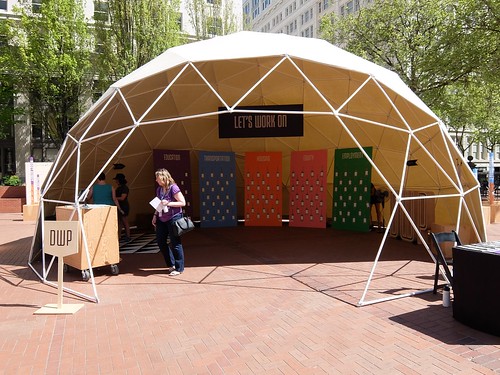I've written about Alan Potkin before, as a gifted geek but more from the satellite photography side of the business.
Alan used to sell a poster, a satellite picture of the Bay Area from space, which helped finance his grad school days lifestyle. He shared it in the course of his presentation.
His poster reminded me of Stewart Brand and his "why haven't we seen any pictures of the whole earth yet?" (this was before Google Earth or any of that, in the years leading up to the first Whole Earth Catalog).
Tonight's audience included at least two attenders I've never met. They asked interesting questions and participated in the discussion of the trade-offs. Major dams have their consequences, that's just physics, some considered beneficial.
Alan's main focus was hydro-electric projects, existing, planned, postponed, dismantled. In Burma, Laos, However he reviewed, in more detail than I'd heard, his role in restoring a famous Lao version of the Ramayana to the newer version of a certain temple.
Detailed photographs from the destroyed temple were projected on the walls of the new temple using techniques Alan pioneered, after some pretty serious processing. Skilled artists turned the projections back into murals.
These projects are connected, in that both feature Alan's meticulous approach to curating and chronicling findings by means of interlinking PDFs, into which he integrates text and pictures, movies.
Why aren't these techniques standard among those charged with writing environmental impact reports? Why is just dry text and tabulated data considered sufficient? Tufte's name came up.
Alan's technique evolved independently of the Internet and its way of doing multimedia, perhaps only locally ("self serve") using 127.0.0.1.
I enjoyed spending time with Alan and his brother Jonathan in downtown Portland earlier, with Glenn Stockton in my company.
Glenn and I took the bus to the Design Week Portland headquarters in Pioneer Courthouse Square (a geodesic dome) and then met up with the two brothers near the KGW studio entrance (part of the Square).
We ended up at the Yard House for lunch, near the Apple Store. Alan's presentation was later that evening at the Linus Pauling House.
Alan used to sell a poster, a satellite picture of the Bay Area from space, which helped finance his grad school days lifestyle. He shared it in the course of his presentation.
His poster reminded me of Stewart Brand and his "why haven't we seen any pictures of the whole earth yet?" (this was before Google Earth or any of that, in the years leading up to the first Whole Earth Catalog).
Tonight's audience included at least two attenders I've never met. They asked interesting questions and participated in the discussion of the trade-offs. Major dams have their consequences, that's just physics, some considered beneficial.
Alan's main focus was hydro-electric projects, existing, planned, postponed, dismantled. In Burma, Laos, However he reviewed, in more detail than I'd heard, his role in restoring a famous Lao version of the Ramayana to the newer version of a certain temple.
Detailed photographs from the destroyed temple were projected on the walls of the new temple using techniques Alan pioneered, after some pretty serious processing. Skilled artists turned the projections back into murals.
These projects are connected, in that both feature Alan's meticulous approach to curating and chronicling findings by means of interlinking PDFs, into which he integrates text and pictures, movies.
Why aren't these techniques standard among those charged with writing environmental impact reports? Why is just dry text and tabulated data considered sufficient? Tufte's name came up.
Alan's technique evolved independently of the Internet and its way of doing multimedia, perhaps only locally ("self serve") using 127.0.0.1.
I enjoyed spending time with Alan and his brother Jonathan in downtown Portland earlier, with Glenn Stockton in my company.
Glenn and I took the bus to the Design Week Portland headquarters in Pioneer Courthouse Square (a geodesic dome) and then met up with the two brothers near the KGW studio entrance (part of the Square).
We ended up at the Yard House for lunch, near the Apple Store. Alan's presentation was later that evening at the Linus Pauling House.


